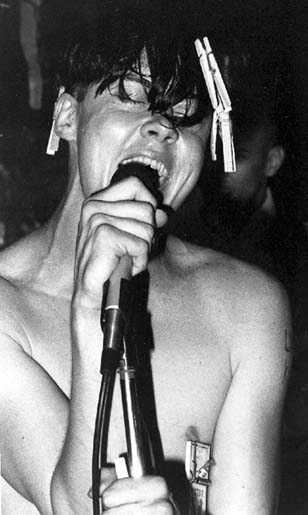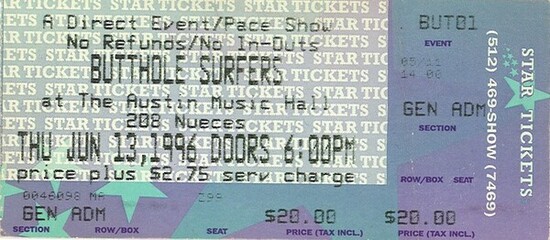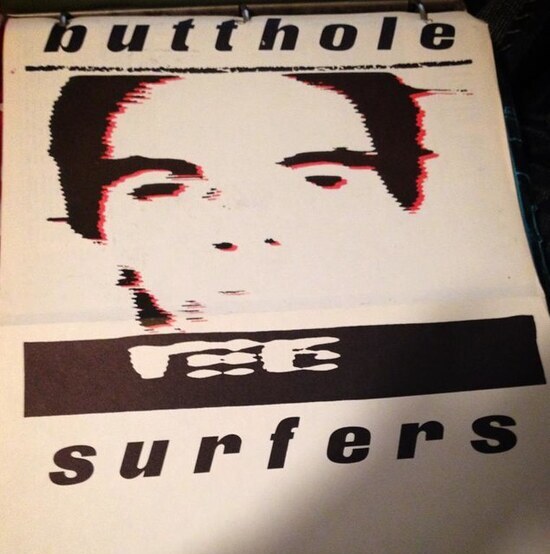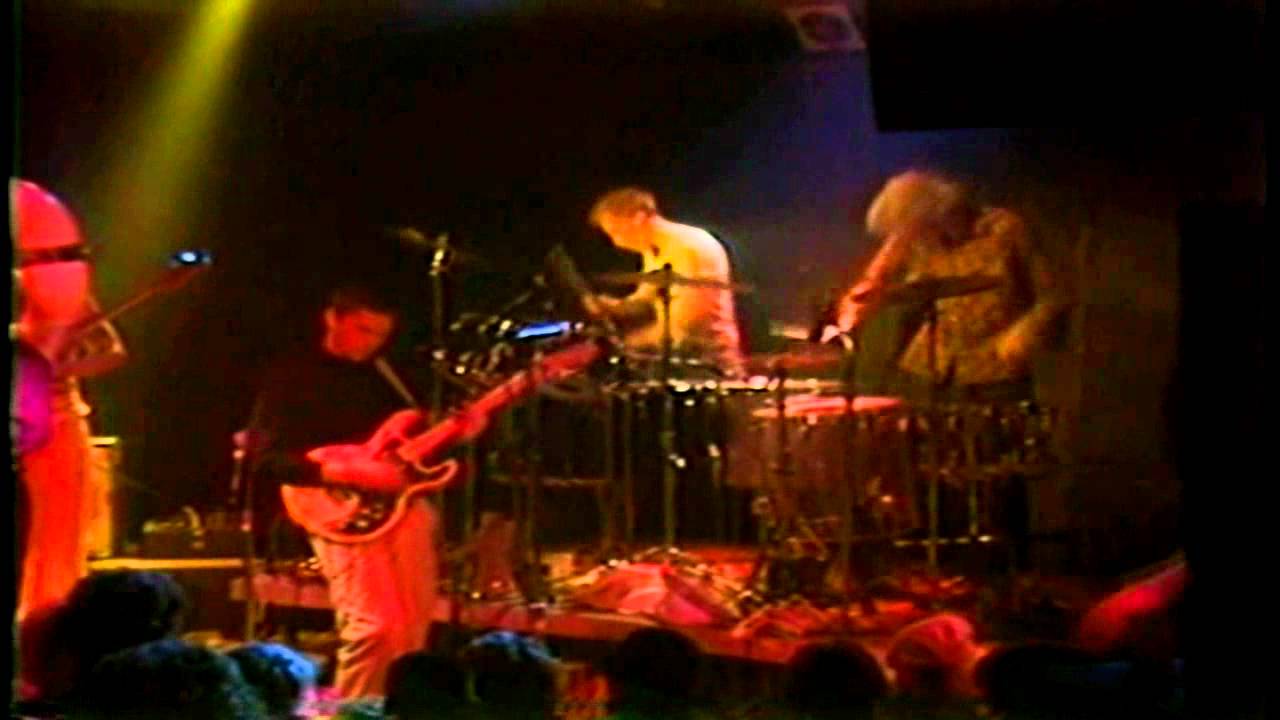Poster for first Butthole Surfers EP on Alternative Tentacles, photo by Pat Blashill
It is no easy feat to summarize Butthole Surfers’ music and career, if you can call it that, in the space of a few pages. A couple of writers have struggled to do it over the course of an entire book. Buttholes Surfers’ history is loaded with what could inadequately be described as ‘antics’. This was, for instance, a band that once relocated to Georgia with the express intention of stalking REM. The move had seemed a tremendous idea when they’d all been tripping, and the Buttholes followed through. Prior to that, the band had remained on tour for two or three years in one virtually unbroken stint, booking gigs as they went along, living like modern nomads. A whole year of this passed by before it dawned on them that it would be a sensible idea to purchase some sleeping bags. During their concerts, which might be more accurately described as ‘events’, a bug-eyed Haynes would fire (blank) shotgun blasts at the heads of his audience. At a festival in the Netherlands, a butt-naked Haynes attempted to invade the stage of Nick Cave & the Bad Seeds. For his insolence, Haynes was booted in the groin by Bad Seeds guitarist Blixa Bargeld. Butthole Surfers had pyromaniac tendencies too, using lighter fluid to set fire to their equipment and also themselves. There was further onstage nakedness courtesy of Kathleen Lynch, formerly known as Ta-Da the Shit Lady, whose occasional eyebrow-raising presence was noise rock’s answer to Hawkwind’s Stacia. At one concert in New York, urine was sprayed onto the crowd by means of the Buttholes’ infamous ‘piss wand’: a Wiffle ball bat that had been filled up with pee. Suffice to say, there were numerous brushes with the law. A lot of weed was smoked. Gallons of beer were guzzled. Soon enough, Butthole Surfers had gained a reputation for sprinkling lsd on their cornflakes first thing in the morning, before Haynes developed a taste for even harder stuff.
Their live shows could be scenes of bacchanalian depravity, both on the part of the band onstage and the spectators below, the separation sometimes blurring in an unsavoury meeting of sex and/or violence of a verbal, visual or physical nature. "One time in Minneapolis," Haynes would recall, "there was a guy who got up on stage and had his dick out and was jacking off this limp dick. Kathleen was up there with her tits way out and this guy was just up there for a long time. Then, after the show, they arrested Kathleen." To accompany the prurience and pyromania, the band utilised seizure-inducing strobe lighting and projections of outlandish movie footage, including stomach-churning clips of car accidents and penis reconstruction surgery. As guitarist Paul Leary always maintained, the only truly satisfying rock music is that which your mother despises and deplores: "We made music that moms would really hate, shows included – like nudity and violence and belching flames and smoke and hideous, loud, damaging music."
Butthole Surfers were founded in 1981 by Haynes and Leary, intelligent Texan kids whose mapped-out career paths went more than a little awry. The son of a local children’s television presenter known as Mr Peppermint, Haynes was a high-school baseball star who went on to study at Trinity University in San Antonio, where he was named Accounting Student of the Year. Leary, who had been raised by schoolteacher parents, was on track to become a stockbroker. Magnetised to each other’s overt eccentricity, the duo began collaborating on a fanzine called Strange V.D. It included reproductions of the grossest medical photographs the pair could get their hands on, accompanied by fictitious explanatory captions. "Case number 36, tacoleg. Or blackbag or pinecone butt or several others. And there’d be pictures of people with distended intestines or huge gashes in their leg or whatever, with, of course, their own descriptions. Still one of the weirdest homemade zines I’ve ever seen in my life," Jello Biafra remembered fondly.
Haynes left his job at the prestigious accounting firm Peat, Marwick, Mitchell shortly after inadvertently leaving a picture of some mutilated genitalia in one of the company’s photocopying machines. After failing to make a living at the less-than-lucrative vocation of manufacturing and flogging bootleg Lee Harvey Oswald merchandise, Haynes and Leary realised it might be easier to start a band. "Where would The Beatles be today if they had called themselves Butthole Surfers?" Leary’s father once asked in a letter to his son. This wasn’t the first name they’d used. Earlier options had been The Dick Clark Five, The Dick Gas Five, The Ashtray Babyheads, Nine Foot Worm Makes Own Food, Vodka Family Winstons, Abe Lincoln’s Bush, Ed Asner’s Gay, and The Right to Eat Fred Astaire’s Asshole (shortened down from The Inalienable Right to Eat Fred Astaire’s Asshole). Later in their career, Haynes was asked whether, if given the chance to do it all over again, he would rewind the clock and make his career trajectory somewhat smoother by giving the band a more palatable moniker. "Yes," he replied, "I would name the band: I’m Going to Shit in Your Mother’s Vagina."

Gibby Haynes in Los Angeles 1984
As unpredictable as they were, and as much as their shows radiated that incredible sensation that anything could happen, there was always a performance art element to Butthole Surfers. They did not lack contrivance. Like seasoned stuntmen, the band would use sugar-glass bottles to attack one another, or to smash over the heads of friends who’d been asked to pose as belligerent stage invaders, fooling the audience into believing they’d witnessed a genuine assault. As Leary hoped to persuade the NME, Butthole Surfers were not particularly outrageous in the grander scheme of things, especially in comparison to some of the more outré acts the band had witnessed on their extensive travels. "I’ve seen some shocking things," he asserted. "That pineapple coming in and out of that guy’s ass at will, that was shocking. The guy shooting hard-boiled eggs out of his ass, with a drag queen standing there eating them, that was pretty shocking." In addition to downplaying their outrageousness, both Haynes and Leary were harsher critics of their own musical abilities than many of their wide-eyed reviewers. As Haynes once put it, "I can write a melody and I can arrange songs. But I am not a musician. I have no technical proficiency at any musical instrument and a limited repertoire with any instrument." This was pretty modest considering he dabbled in the saxophone, wood- block, guitar, bass and drums, and was particularly adept when it came to altering and manipulating the sound of his own voice, be it by singing through toilet rolls or a megaphone, or assembling a rack of equipment – known as ‘Gibbytronix’ – with which he was able to distort, mutate and live-loop his vocals in such a loud and terrifying way that it successfully out-heavied your average guitarist’s range of effects pedals. For his own part, Leary had been playing electric guitar since before the age of 10, after witnessing the Beatles’ historic appearance on The Ed Sullivan Show. Leary, too, denied that he was a good musician: "Sometimes it’s hard for me to even think of our music as music . . . It has been more of a platform to express ourselves, even though we don’t know what we are trying to express. I was pretty mad at the world for a while." Drummer King Coffey was prouder of the band’s achievements, albeit with firm provisos. ‘When we really hit it,’ he said in 1996, "I think we’re the best band on the planet. We picked up where Pink Floyd left off and added the wisdom of punk rock. We’re not performance art anymore, but we are visual art in a rock mode."
As important as visuals were to the band, presence at one of their sensory-overloading live shows was not a necessary prerequisite for having one’s mind warped by Butthole Surfers. Nor did one have to gaze at a freakish Buttholes record sleeve for a sustained period to experience an epiphany. Their music contained – and still possesses – that potent power all by itself, no matter how amateurish the band considered their studio performances to be. There’s the ugly and lo-fi psych-punk of 1984’s Psychic . . . Powerless . . . Another Man’s Sac, with its fevered guitar tones and vocals that sound like Haynes had a groan tube lodged in his throat for much of the recording process. Then there’s the trudging pace and almost gothically ren- dered mental fragility of Rembrandt Pussyhorse (1986). That was followed a year later by the denser and meatier screwed-up rock shapes of Locust Abortion Technician. Mind you, talking of visuals, that album’s creepy clown artwork is a contender for the most apt record sleeve of all time.
"I wish I was Neil Young," lamented Haynes in 1996, showing that Butthole Surfers’ obsession with famous musicians was by no means limited to stalking REM. "I’m not known for writing good songs. I’m known for putting my foot in my mouth and saying funny things . . . I just wish I didn’t suck." A decade earlier, Butthole Surfers had used piano chords lifted from Young’s ‘Heart of Gold’ as the basis for their cockeyed country track Creep in the Cellar’. Also included on Rembrandt Pussyhorse was a rendition of ‘American Woman’, accurately described by Michael Azerrad as a "bizarre, almost cubist deconstruction" of The Guess Who’s original. Other Butthole covers included Donovan’s ‘Hurdy Gurdy Man’ and ‘The One I Love’ by their beloved REM. The Buttholes also had a healthy habit of pinching material from Black Sabbath. The drum pattern on ‘Dum Dum’ was stolen from ‘Children of the Grave’, while ‘Sweat Loaf’ was an unhinged semi-cover of Sabbath’s timeless weed anthem ‘Sweet Leaf’. A direct reply to Sabbath was offered via the track ‘No, I’m Iron Man’. Butthole Surfers’ album titles took to running classic rock through the mangle too. See the Hairway to Steven LP or Electric Larryland. The former took the mock-tributes a step further by featuring no track names on its sleeve. In place of words, each song was represented by its own distinct symbol. This was a nod to Led Zeppelin’s fourth lp, the difference being that where Zeppelin had come up with runes, the Buttholes used stick drawings.
Such irreverent iconoclasm did not deter John Paul Jones from producing Independent Worm Saloon in 1993. The legendary bassist presumed he’d been hired to give the album "a heavy rock vibe", adding that "it didn’t work out like that." His reputation among the Buttholes can only have been enhanced by the fact that Jones had previously worked on the orchestrations for REM’s Automatic for the People. Haynes remembered Jones as being "like a horrible drunk when we were doing that record," adding, "but we were loaded too . . . We basically spent a fortune to hang out with some guy from Led Zeppelin." The guy in question was not a fan of the band’s "swirly songs," and this major-label debut did not turn out to be as overtly weird as the band’s previous output. It still contained plenty of warped vocal and instrumental effects and other unusual forms of experimentation. ‘Tongue’ ends with a recording of somebody urinating, for example, while the final track incorporates a long loop of retch-inducing vomiting noises, which the band had been tempted to stretch out for forty minutes and submit to the label as their completed masterpiece. The album’s love songs, if that is what they are, were conceived from characteristically odd vantage points. These include ‘Dog Inside Your Body’, the titular lyrics being either metaphorical or denoting a Bulgakovian tale of cross-species metamorphosis, and ‘Goofy’s Concern’, which could be mistaken for a nihilistic hardcore anthem unless full attention is paid to its tender final line. In spite of Jones’s qualms, those two tracks did indeed rock hard, as did many others, in a delightfully twisted and ramshackle way.

Butthole Surfers peaked commercially in 1996 with a hit called ‘Pepper’. Many compared it to Beck, although it’s hard to imagine the charismatic ‘Loser’ star rapping about high-school rapists, amputees, car-crash victims and HIV. Earlier in their career, Butthole Surfers had recorded jingles for MTV. More recently, in 2019, their exploits were reproduced in a lavish coffee-table book, a dubiously highbrow honour for such a lairy noise rock band. Whatever they got up to, the band’s members always batted off accusations of having sold out. As far as Coffey was concerned, their name alone served as a permanent badge of integrity. They could sound like Barry Manilow, for all Coffey cared. As long as they called themselves Butthole Surfers, no charge of selling out would be able to stick. Haynes saw no shame in experimenting with different musical styles, from avant-garde audio collages to skewed takes on country and pop. After all, he argued, the Beatles were rightly admired for their ability to create strange psychedelic compositions as well as politer tunes like ‘Rocky Racoon’. Nor had the Surfers ever concealed their ambitions, no matter how unlikely their commercial prospects always seemed to be. From its outset, said Leary, the band had consistently strived to afford superior equipment, nicer accommodation, better transport and higher-quality marijuana. The guitarist had no tolerance for the pious disapproval of indie purists and felt over the moon when his band signed to the same label that had put out records by Grand Funk Railroad. Besides, who can blame them after hearing about their early sleeping-bagless days of washing dishes between live dates, foraging for cans and bottles to exchange for the nickel deposit, getting attacked by redneck thugs as soon as they walked into a diner and suffering flu on the road for six months at a time?
In spite of the fact that the footage was sometimes screened in reverse, and as graphic as that footage was, there was nothing fundamentally depraved about an instructional film documenting the surgical reconstruction of the shredded penis of an Iowan farmer who’d accidentally caught his trousers in a combine harvester. "It’s a success story, actually," as King Coffey observed. The same thing might be said of Butthole Surfers. Just don’t show either example to your mother.
JR Moores, Electric Wizards: A Tapestry of Heavy Music, 1968 to the Present is published by Reaktion Books on 13 September



